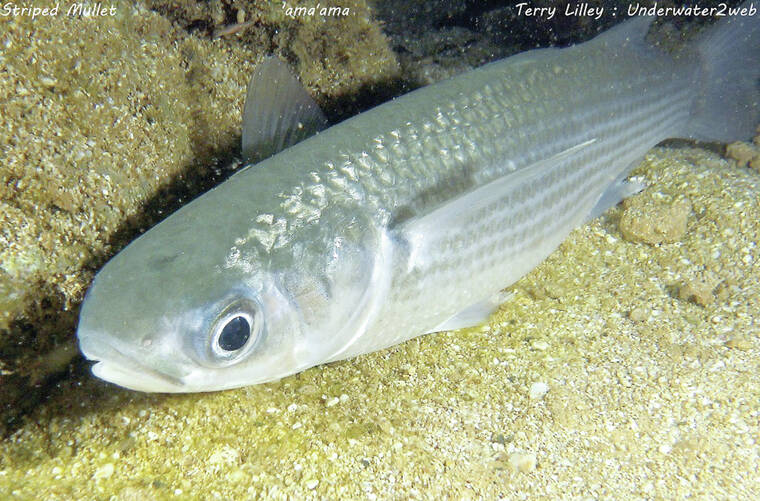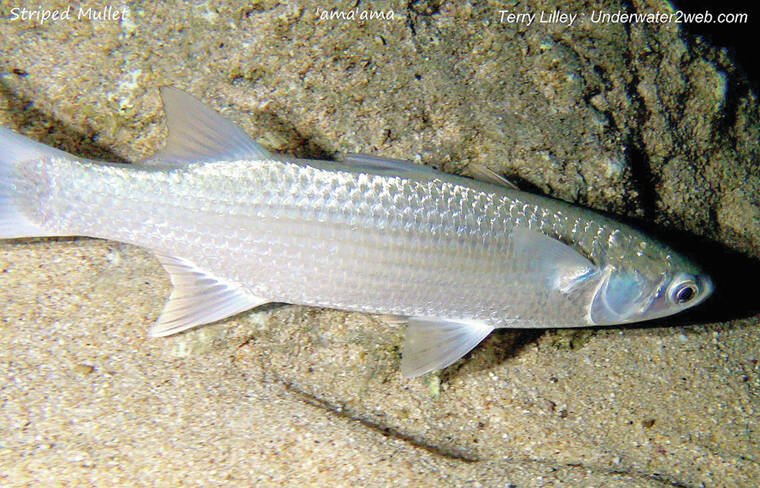I you surf here in Hawai‘i you have more than likely paddled your surfboard right over dozens of these large silver fish that can grow to about two foot long and were a prize seafood for Hawaiian royalty in the past. The Striped Mullet lives in schools right in the shore break and their silver color blends in with the foam and bubbles created by the waves hitting the shoreline.
I you surf here in Hawai‘i you have more than likely paddled your surfboard right over dozens of these large silver fish that can grow to about two foot long and were a prize seafood for Hawaiian royalty in the past. The Striped Mullet lives in schools right in the shore break and their silver color blends in with the foam and bubbles created by the waves hitting the shoreline.
You will see fishermen throwing their nets right in the shallow surf to try and catch ‘ama’ama but only the most skilled fishermen are successful because the fish live in such shallow turbulent water that tends to snag the net on rocks. This fish is so illusive and hard to see that I go out at night to shoot video of them because they rest on the sand when they sleep and their silver color reflects my dive lights and makes them shine like a light bulb tuned on!
Striped mullets are very good to eat and they can live in very shallow brackish water so they were one of preferred fish species in old Hawai‘i that was raised in the fish ponds. This fish was one of the most important food items that it was given different names for different sizes.
The ‘ama’ama are all hatched out as females and when they are babies they are called pua’ama but as they grow they can change sexes and when they are medium size they are called kahaha and as they reach adults they get their most familiar name of ‘ama’ama. Sometimes the very large adults are called ‘anae. Having all of these different names has made the identification of these fish fairly difficult because they look similar to the Pacific Threadfin (moi) and the Sharpnose mullet (uouoa).
The breeding habits or the ‘ama’ama are still quite a mystery but we know they come into shallow lagoons, streams and rivers to lay their eggs. What happens to the babies when they hatch is now being studied and there have been some interesting research that has shown that the babies may float around in sea surface slicks that are blown by the wind. Mullets hatched on one island may end up floating on the sea surface and end up on a different island.
The island of Ni‘ihau has schools of adult ‘ama’ama and fishermen there have been drawing pictures of the fish for hundreds of years but there is no good estuaries on Ni‘ihau for the fish to reproduce in.
The fishermen in Ni‘ihau did not have names for the baby ‘ama’ama but on the west side of Kaua‘i the fisherman observed baby Striped Mullets and had names for them. We now think that the fish may breed in Kaua‘i and the babies drift in currents out to Ni‘ihau.
Someday I hope to do DNA studies to verify this.
What the ‘ama’ama shows us is how inner connected the Hawaiian Islands are. A polluted river on one island may harm the breeding of the ‘ama’ama and that may harm the entire population of this valuable fish on a completely different island. In old Hawai‘i the fishing kahuna understood the connection between the fish from island to island and they established strict rules (kapu) about when and where you could catch the fish and they also had marine reserves that forbid taking the fish during breeding season.
We can lean from this vast knowledge to help our current studies so we can protect this vital resource for future generations.
•••
Terry Lilley is a marine biologist living in Hanalei Kaua‘i and co-founder of Reef Guardians Hawai‘i, a nonprofit on a mission to provide education and resources to protect the coral reef. To donate to Reef Guardians Hawaii go to www.reefguardianshawaii.org.

Subscribe today for unlimited access.
Already a subscriber?
Login
Not ready to subscribe?
Register for limited access.
If you have a print subscription but require digital access,
activate your account.






